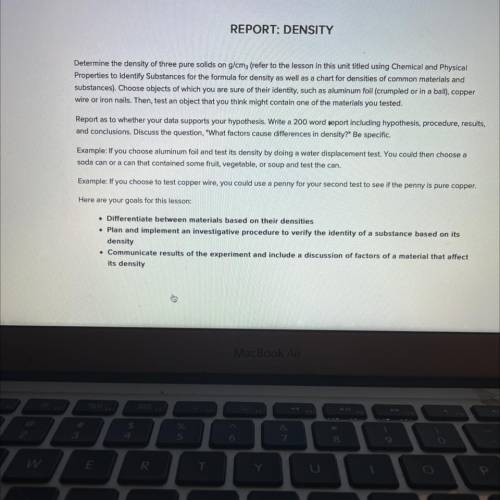
REPORT: DENSITY
Determine the density of three pure solids on g/cm3 (refer to the lesson in this unit titled using Chemical and Physical
Properties to identify Substances for the formula for density as well as a chart for densities of common materials and
substances). Choose objects of which you are sure of their identity, such as aluminum foil (crumpled or in a ball), copper
wire or iron nails. Then, test an object that you think might contain one of the materials you tested.
Report as to whether your data supports your hypothesis. Write a 200 word Geport including hypothesis, procedure, results,
and conclusions. Discuss the question, "What factors cause differences in density?" Be specific.
Example: If you choose aluminum foil and test its density by doing a water displacement test. You could then choose a
soda can or a can that contained some fruit, vegetable, or soup and test the can.
2
Example: If you choose to test copper wire, you could use a penny for your second test to see if the penny is pure copper.
Here are your goals for this lesson:
Differentiate between materials based on their densities
• Plan and implement an investigative procedure to verify the identity of a substance based on its
density
• Communicate results of the experiment and include a discussion of factors of a material that affect
its density


Answers: 2
Other questions on the subject: Chemistry

Chemistry, 21.06.2019 20:30, jbarbie3
12. complete each of the following word equations for synthesis reactions. a. sodium + oxygen -> b. magnesium + fluorine -> 13. complete and balance the equations for the decomposition reactions. a. hgo -> [with the triangle heat symbol above the arrow] b. h2o(l) -> [with "electricity" written above the arrow]
Answers: 1

Chemistry, 22.06.2019 05:30, MansellS5529
A3.37-mg sample of protein was chemically digested to convert its nitrogen into ammonia and then diluted to 100.0 ml. then 10.0 ml of this solution was placed in a 50-ml volumetric flask and treated with 5 ml of phenol solution plus 2 ml of sodium hypochlorite solution. the sample was diluted to 50.0 ml, and the absorbance at 625 nm was measured in a 1.00-cm cuvette and found to be 0.486. for reference, a standard solution was prepared from 10.0 mg of nh4cl (molar mass = 53.49 grams/mole) dissolved in 1.00 l of water. then 10.0 ml of this standard was placed in a 50-ml volumetric flask, treated in the same manner as the unknown, and the absorbance found to be 0.323. finally, a reagent blank was prepared using distilled water in place of unknown, it was treated in the same manner as the unknown, and the absorbance found to be 0.076. calculate the weight percent of nitrogen in the protein.
Answers: 1
Do you know the correct answer?
REPORT: DENSITY
Determine the density of three pure solids on g/cm3 (refer to the lesson in this u...
Questions in other subjects:



Social Studies, 23.07.2019 05:00

History, 23.07.2019 05:00


History, 23.07.2019 05:00



Physics, 23.07.2019 05:00






